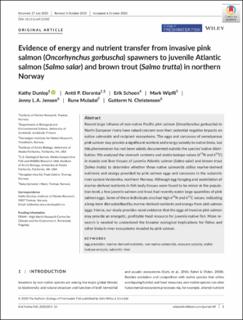| dc.contributor.author | Dunlop, Katherine Mary | |
| dc.contributor.author | Eloranta, Antti | |
| dc.contributor.author | Schoen, Erik | |
| dc.contributor.author | Wipfli, Mark | |
| dc.contributor.author | Jensen, Jenny Lovisa Alexandra | |
| dc.contributor.author | Muladal, Rune | |
| dc.contributor.author | Christensen, Guttorm N. | |
| dc.date.accessioned | 2020-11-19T10:55:01Z | |
| dc.date.available | 2020-11-19T10:55:01Z | |
| dc.date.created | 2020-11-18T08:42:43Z | |
| dc.date.issued | 2020 | |
| dc.identifier.issn | 0906-6691 | |
| dc.identifier.uri | https://hdl.handle.net/11250/2688653 | |
| dc.description.abstract | Recent large influxes of non-native Pacific pink salmon (Oncorhynchus gorbuscha) to North European rivers have raised concern over their potential negative impacts on native salmonids and recipient ecosystems. The eggs and carcasses of semelparous pink salmon may provide a significant nutrient and energy subsidy to native biota, but this phenomenon has not been widely documented outside the species' native distribution. We analysed the stomach contents and stable isotope values (δ15N and δ13C) in muscle and liver tissues of juvenile Atlantic salmon (Salmo salar) and brown trout (Salmo trutta) to determine whether these native salmonids utilise marine-derived nutrients and energy provided by pink salmon eggs and carcasses in the subarctic river system Vesterelva, northern Norway. Although egg foraging and assimilation of marine-derived nutrients in fish body tissues were found to be minor at the population level, a few juvenile salmon and trout had recently eaten large quantities of pink salmon eggs. Some of these individuals also had high δ15N and δ13C values, indicating a long-term diet subsidised by marine-derived nutrients and energy from pink salmon eggs. Hence, our study provides novel evidence that the eggs of invasive pink salmon may provide an energetic, profitable food resource for juvenile native fish. More research is needed to understand the broader ecological implications for fishes and other biota in river ecosystems invaded by pink salmon. egg predation, marine-derived nutrients, non-native salmonids, resource subsidy, stable isotope analysis, subarctic river | |
| dc.language.iso | eng | |
| dc.title | Evidence of energy and nutrient transfer from invasive pink salmon (Oncorhynchus gorbuscha) spawners to juvenile Atlantic salmon (Salmo salar) and brown trout (Salmo trutta) in northern Norway | |
| dc.type | Peer reviewed | |
| dc.type | Journal article | |
| dc.description.version | publishedVersion | |
| dc.subject.nsi | VDP::Zoologiske og botaniske fag: 480 | |
| dc.subject.nsi | VDP::Zoology and botany: 480 | |
| dc.source.journal | Ecology of Freshwater Fish | |
| dc.identifier.doi | 10.1111/eff.12582 | |
| dc.identifier.cristin | 1849015 | |
| dc.relation.project | Andre: FRAM - High North Research Centre for Climate and the Enviro | |
| cristin.ispublished | true | |
| cristin.fulltext | original | |
| cristin.qualitycode | 1 | |
